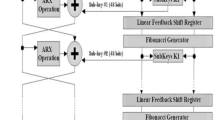Abstract
In the last few years, there have been more and more security vulnerabilities in IoT devices. Some authors suggest the use of security algorithms and methods used on computers for protection, but in this paper, we propose that some hash encryption algorithms can be used in IoT application to provide integrity and authenticity of a message. It can be used when the risk of data misuse and the need for strong protection are low.
Five different development boards are tested to prove that the proposed HMAC algorithm is not too computing-intensive. mbedTLS library has been used, and performance (speed) of boards have been measured with different secret key and payload size. We concluded that SHA256 and HMAC-SHA256 algorithms could be taken into account when deciding on the application of cryptography, primarily due to the ease of use and a low load of the microcontroller.
Access this chapter
Tax calculation will be finalised at checkout
Purchases are for personal use only
Similar content being viewed by others
References
Ashton, K., et al.: That ‘internet of things’ thing. RFID J. 22, 97–114 (2009)
Woolf, N.: DDoS attack that disrupted internet was largest of its kind in history, experts say. The Guardian, 26 October 2016. https://www.theguardian.com/technology/2016/oct/26/ddos-attack-dyn-mirai-botnet. Accessed 16 May 2020
Zimmerli, L., Schläpfer, T., Rüst, A.: Securing the IoT: introducing an evaluation platform for secure elements. In: Konferenz Internet of Things-vom Sensor bis zur Cloud, Stuttgart, Deutschland, 20. November 2019 (2019)
Atzori, L., Iera, A., Morabito, G.: The internet of things: a survey. Comput. Netw. 54, 2787–2805 (2010)
Vongsingthong, S., Smanchat, S.: Internet of things: a review of applications and technologies. Suranaree J. Sci. Technol. 21, 359–374 (2014)
Yang, Q., Wang, Z., Yue, Y.: Summarize the technology of the things of Internet. In: 2012 2nd International Conference on Consumer Electronics, Communications and Networks (CECNet) (2012)
Arduino: Software, Arduino. https://www.arduino.cc/en/main/software. Accessed 22 May 2020
Trusted Firmware: https://www.trustedfirmware.org/. Accessed 23 May 2020
Columbus, L.: Iot market predicted to double by 2021, reaching $520b, Forbes, 16 August 2018. https://www.forbes.com/sites/louiscolumbus/2018/08/16/. Accessed 23 May 2020
Gillett, F.: Predictions 2020: IoT Expansion Brings Even More Change,” Forrester, 1 November 2019. https://go.forrester.com/blogs/predictions-2020-iot/. Accessed 15 May 2020
Bastos, D.: Cloud for IoT-a Survey of Technologies and Security features of Public Cloud IoT solutions (2019)
Bastos, D., Shackleton, M., El-Moussa, F.: Internet of Things: a survey of technologies and security risks in smart home and city environments (2018)
El Jaouhari, S., Bouabdallah, A., Bonnin, J.-M., Lemlouma, T.: Securing the communications in a wot/webrtc-based smart healthcare architecture. In: 2017 14th International Symposium on Pervasive Systems, Algorithms and Networks & 2017 11th International Conference on Frontier of Computer Science and Technology & 2017 Third International Symposium of Creative Computing (ISPAN-FCST-ISCC) (2017)
Pearson, B., Luo, L., Zhang, Y., Dey, R., Ling, Z., Bassiouni, M., Fu, X.: On misconception of hardware and cost in IoT security and privacy. In: ICC 2019-2019 IEEE International Conference on Communications (ICC) (2019)
Li, Y.: An integrated platform for the internet of things based on an open source ecosystem. Fut. Internet 10, 105 (2018)
Zhang, E.P., Fang, J., Li, D.C.C., Ching, M.W.H., Chim, T.W., Hui, L.C.K., Yiu, S.M.: A simple and efficient way to combine microcontrollers with RSA cryptography. Comput. Sci. (LNECS) 2207, 7–11 (2013)
Thingsturn: Thingsturn.com, Thingsturn. https://www.thingsturn.com/. Accessed 21 May 2020
STMicroelectronics: NUCLEO-L476RG - STM32 Nucleo-64 development board with STM32L476RG MCU, supports Arduino and ST morpho connectivity, STMicroelectronics. https://www.st.com/en/evaluation-tools/nucleo-l476rg.html. Accessed 23 May 2020
Espressif: ESP32 Series Datasheet (2020). https://www.espressif.com/sites/default/files/documentation/esp32_datasheet_en.pdf. Accessed 14 May 2020
Seeed: Sipeed MAix BiT for RISC-V AI + IoT. https://www.seeedstudio.com/Sipeed-MAix-BiT-for-RISC-V-AI-IoT-p-2872.html. Accessed 12 May 2020
Embedded Microprocessor Benchmark Consortium: About EEMBC, Embedded Microprocessor Benchmark Consortium (2020). https://www.eembc.org/about/. Accessed 15 July 2020
Berkeley Design Technology, Inc.: Overview of BDTI Services, Berkeley Design Technology, Inc. (2020). https://www.bdti.com/company/overview-of-bdti-services. Accessed 15 July 2020
Nakutis, Ž.: Embedded microcontrollers benchmarking using sliding window algorithm. Elektronika ir Elektrotechnika 75, 49–52 (2007)
Kumar, U., Borgohain, T., Sanyal, S.: Comparative analysis of cryptography library in IoT. CoRR, vol. abs/1504.04306, 2015
Bakker, P.: PolarSSL is now a part of ARM, arm mbed, 24 November 2014. https://tls.mbed.org/tech-updates/blog/polarssl-part-of-arm. Accessed 25 May 2020
Penard, W., van Werkhoven, T.: On the secure hash algorithm family. Cryptography in Context, pp. 1–18 (2008)
National Institute of Standards and Technology: Announcing Approval of Federal Information Processing Standard (FIPS) 180-2, Secure Hash Standard; a Revision of FIPS 180-1, 26 August 2002. https://www.federalregister.gov/documents/2002/08/26/02-21599/announcing-approval-of-federal-information-processing-standard-fips-180-2-secure-hash-standard-a. Accessed 24 May 2020
IETF Secretariat: IPR Details, IETF Secretariat, 20 June 2007. https://datatracker.ietf.org/ipr/858/. Accessed 22 May 2020
Glenn, L.M.: Device for and method of one-way cryptographic hashing. United States of America Patent US6829355B2, 5 March 2001
Bellare, M., Canetti, R., Krawczyk, H.: Keying hash functions for message authentication (1996)
Turner, S., Chen, L.: Updated security considerations for the MD5 message-digest and the HMAC-MD5 algorithms (2011)
Gulley, S., Gopal, V., Yap, K., Feghali, W., Guilford, J., Wolrich, G.: Intel SHA Extensions, July 2013. https://software.intel.com/content/dam/develop/external/us/en/documents/intel-sha-extensions-white-paper-402097.pdf. Accessed 12 June 2020
Larabel, M.: AMD starts linux enablement on next-gen “Zen” Architecture. Phoronix Media, 17 March 2015. https://www.phoronix.com/scan.php?page=news_item&px=AMD-Zen-CPU-Znver1. Accessed 1 June 2020
ARM: ARM Cortex-A53 MPCore Processor (2014). http://infocenter.arm.com/help/topic/com.arm.doc.ddi0500e/DDI0500E_cortex_a53_r0p3_trm.pdf. Accessed 2 June 2020
Durand, A., Gremaud, P., Pasquier, J., Gerber, U.: Trusted lightweight communication for IoT systems using hardware security. In: Proceedings of the 9th International Conference on the Internet of Things, New York, NY, USA (2019)
Author information
Authors and Affiliations
Corresponding author
Editor information
Editors and Affiliations
Rights and permissions
Copyright information
© 2020 Springer Nature Switzerland AG
About this paper
Cite this paper
Dokic, K., Mesic, T., Cobovic, M. (2020). Analysis of Available Microcontroller Computing Resources for the Application of Some Cryptographic Hash Functions on Different Internet of Things Platforms. In: Dziech, A., Mees, W., Czyżewski, A. (eds) Multimedia Communications, Services and Security. MCSS 2020. Communications in Computer and Information Science, vol 1284. Springer, Cham. https://doi.org/10.1007/978-3-030-59000-0_13
Download citation
DOI: https://doi.org/10.1007/978-3-030-59000-0_13
Published:
Publisher Name: Springer, Cham
Print ISBN: 978-3-030-58999-8
Online ISBN: 978-3-030-59000-0
eBook Packages: Computer ScienceComputer Science (R0)




